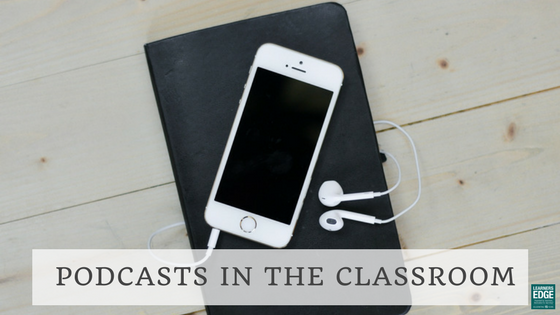Teachers, Listen up! Any of the following sound true for you?
- Your students’ assessments are lacking in differentiation and variety.
- Your students want to delve deeper into a topic beyond your knowledge base.
- A student is absent for a week, and you need to find a way to catch her up with the rest of the class.
- You want to infuse more technology into your classroom instruction using simple and accessible tools you can count on.
Podcasting offers a solution to all of the above, and more!
It’s true, teachers must strive to integrate more technology into classroom instruction. It’s also true, there are so many new tools, apps, and other digital resources available that the quest can become nightmarish for even the bravest techie teachers. How to find relevant, age-and content- appropriate, quality, free (or at least cheap) tech tools and apps becomes the bottom line. It all adds up to time – time to investigate and experiment; time to access, upload or download; time to learn, practice, and add into your instruction.
It’s true, time is always a crunch factor, isn’t it?
Learners Edge distance-learning courses always contain technology tools and applications that support teachers who want or need to engage with a specific instructional technology. It’s best practice to push each other and ourselves further into the world of digital learning. Recently our Curriculum and Instruction team brainstormed a list of tech course options to focus on one specific tech tool or application with enough background learning and implementation activities to successfully connect to classroom instruction. We set out to create one-credit tech adventures for time-crunched teachers like you.
Since I’m a podcast fan, it was a blast to dig in and write a course on Podcasting in the Classroom. Here’s a quick look at podcasting possibilities:
There are two powerful components to podcasting in the classroom:
- Consumer – Listening
- Producer- Creating
After investigating both components and trying out some basic applications, you will begin to notice the engagement value of podcasting:
- Applicable with any subject and topic of study or interest
- Create podcasts using free apps – like Audacity (PC), or GarageBand (Mac)
- Research and create content to share on any subject with a specific audience and purpose in mind
- Collaboration for students
- Use Chromebooks or iPads, common school-issued computers with free recording apps and tools
- Easy-to-access free educational podcasts through iTunes
But wait – don’t just take my word for it! Check out one (or all) of these favorite podcasts for teachers and students. These podcast series offer episodes ranging from 5-60 minutes and can be experienced from any computer or mobile device. Grab your headphones and listen up!
- TalksWithTeachers-The Zen Teacher
- EdChatRadio – Moving From Compliance to Meaningful Student Engagement
- NPR But Why? A Podcast for Curious Kids
- Brains On!
- NPR – Stories Alive!
- Tumble – Science Podcast For Kids
- Book Club For Kids
- Short & Curly
- The Show About Science
- Classics For Kids
Here are some quick ideas for how to use podcasts as consumers and producers in your classroom:
- Book talks – this one is probably the most common “go-to” for podcast activities. There are a million ways you can have students share about books they have read, either individually or collaboratively. You can create a routine format that works as an ongoing outcome for independent reading or rotate target skill templates you want to reinforce with this assignment.
- A huge component of writing instruction is sharing and celebrating student work. Podcasts provide a means for this to happen consistently. Create a podcast repository on your online classroom website for sharing student writing. Designate days when the whole class becomes podcast listeners with a possible goal to give feedback on both the writing and speaking of the podcast presentation. Podcasts can easily be shared with parents, too – consider posting podcasts for family listening pleasure.
- PSA (public service announcement) podcasts are a perfect way for students to demonstrate outcomes related to persuasive writing, word choice, science, health, social issues, school or community concerns…..and the list goes on.
- Science is filled with systems, cycles, and experiment results – creating podcasts to share science learning solidifies student outcomes for creators and listeners. Think of it these as “another way to explain” or “reviewing content” for any important science concept you want students to master.
- How about a social studies or history podcast? Pick a person to study and dig deeper into their stories to present as podcasts for peers. This enhances any unit of study and gives individual students ownership of specific content.
It’s true, teaching and learning with podcasts has powerful potential. Teach more with technology and join us for Course 800: Hit “Play” for Podcasts in the Classroom where you will learnimportant background basics for podcasting, as well as podcast ideas for students that can be directly integrated into any classroom at any grade level.






